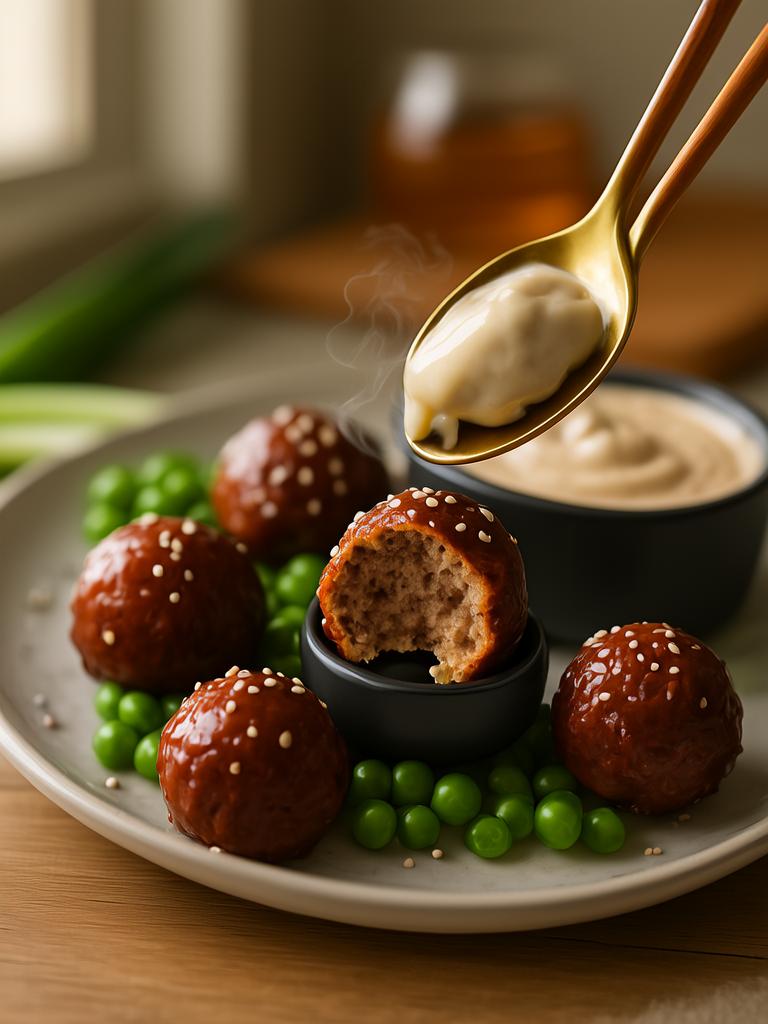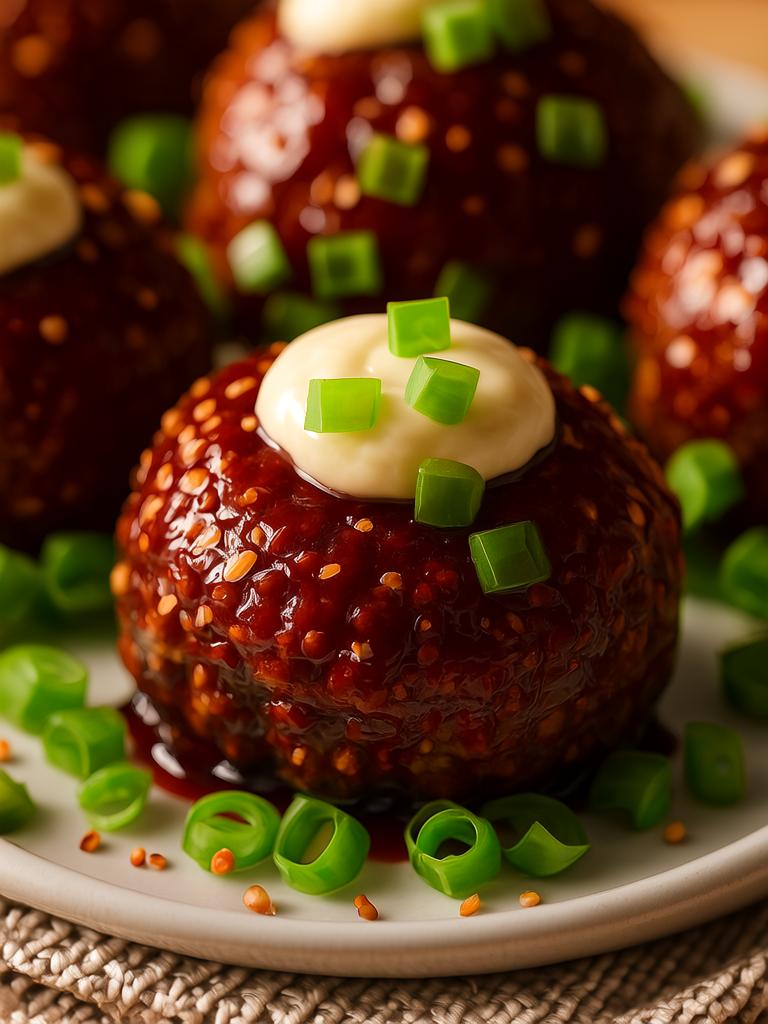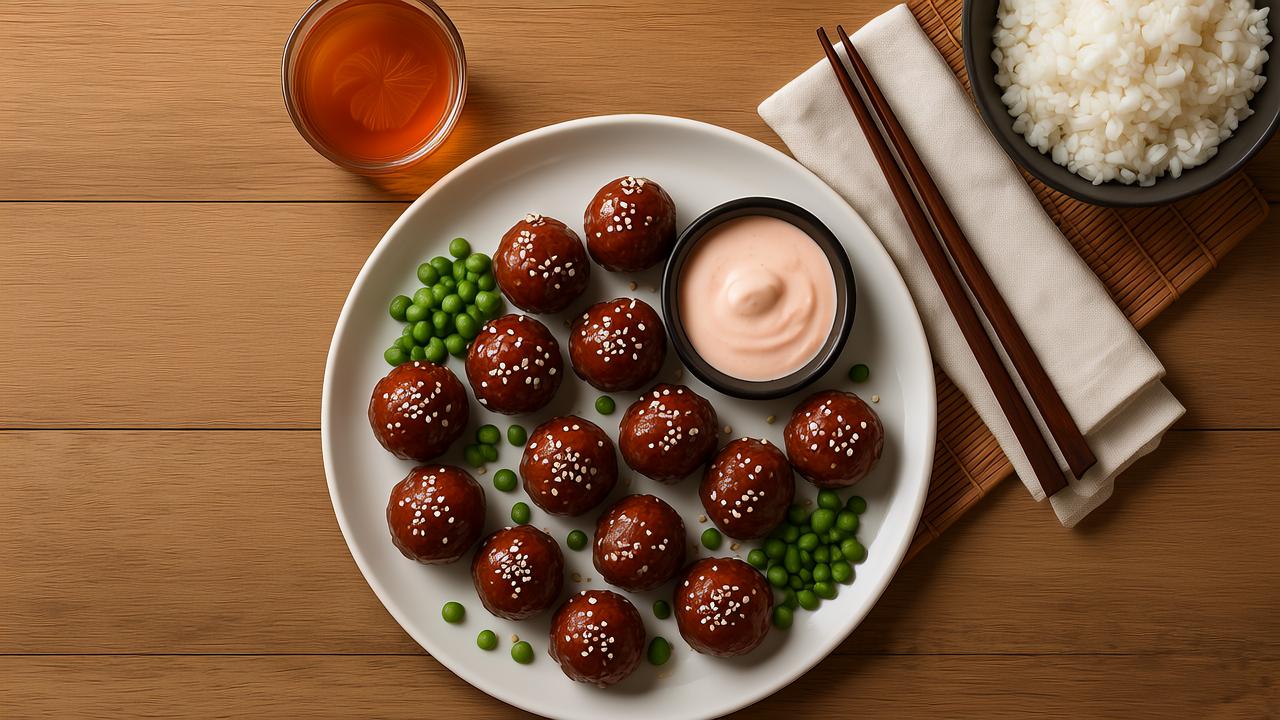What happens when bold Korean flavors meet Western comfort food in a bite-sized package? You get something kinda magic—Sweet & Spicy Korean BBQ Meatballs with Creamy Mayo Dip. These little flavor bombs are more than just trendy appetizers. They’re an artful balance of heat, sweetness, umami, and creamy coolness that plays tricks on your taste buds—in the best way.
In this piece, I’ll break down what makes these meatballs tick, why chefs and serious home cooks alike should care, and how to perfect the recipe using real-deal culinary technique. If you’re in the food biz or just cooking like you are, this dish deserves a place in your rotation.
Let’s get straight into the skillet.
Why Korean BBQ Meatballs Work (and Why They Sell)
There’s a reason Korean flavors have taken over menus across the globe. It’s that layered complexity: sweet, salty, spicy, fermented, smoky—all working together like a really tight jazz band.
And when you shrink that into a meatball? It’s just smart. Korean BBQ meatballs are portable, prep-friendly, freezer-friendly, and, honestly, addictive. You can scale ‘em for meal prep or plate ‘em for a $22 small plate at a hip fusion bistro.
The trick? Balance. You need a meatball that doesn’t fight with the sauce. One that soaks up flavor without getting soggy. And a dip that cools it all down without stealing the show.
If you nail those three things, you’ve got a crowd-pleaser that doesn’t care who’s eating—foodie or fast-casual diner.
The Meatball Base: Foundation First
The best Korean BBQ meatballs start with a protein blend. Just beef? Bit too dense. Just pork? Too fatty, greasy sometimes. But a 50/50 beef and pork blend? Now we’re cookin’.
I use:
- 1 lb ground beef (80/20)
- 1 lb ground pork
- 1/2 cup panko breadcrumbs
- 1/4 cup finely chopped scallions
- 2 cloves garlic, grated
- 1 egg
- 1 tbsp sesame oil
- 1 tsp soy sauce
- 1/2 tsp gochugaru (Korean chili flakes)
- Pinch of white pepper
You want that meatball to feel juicy but tight. No one likes a meatball that falls apart in sauce. The panko gives lightness. The egg binds. Sesame oil and soy give umami from the inside out.
Now, this bit’s weird but true: Let your mix rest in the fridge for at least 30 mins before forming. Cold mix holds together better and absorbs flavors. That’s science and kitchen wisdom from Korean ajummas who’ve been rolling meat since before you were born.

Shaping and Cooking: Don’t Overthink It
Meatballs should be bite-sized. About 1.5 inches in diameter. Use a scoop if you want consistency, or go rogue and freestyle ‘em. I won’t judge. What matters more is how you cook.
Bake vs. pan-fry vs. deep-fry?
- Bake if you’re feeding a crowd.
- Pan-fry if you want a little crisp on the outside.
- Deep-fry if you’re a maniac with a fryer and a dream.
I prefer baking at 400°F for about 15–18 mins. Line your tray, flip halfway through. Easy cleanup, no oil splatter, and still golden brown. Done.
That Sauce Though: Sweet, Spicy, Sticky, Unreal
This is the star. The sauce needs to scream Korean BBQ but whisper “I go great with meatballs.”
Here’s the mix:
- 1/2 cup gochujang (Korean fermented chili paste)
- 1/3 cup honey
- 1/4 cup soy sauce
- 2 tbsp rice vinegar
- 2 tbsp brown sugar
- 2 cloves garlic, minced
- 1 tbsp ginger, grated
- 1 tbsp sesame oil
- Optional: splash of mirin or sake
Simmer low till it bubbles like lava. Then reduce until it’s syrupy. Not too thick—you want it to coat, not clump.
Gochujang brings that fermented heat. Honey and sugar round it out. Vinegar cuts through the richness. Garlic and ginger? They’re the heartbeat of Korean cooking. Don’t skip them.
You can toss the baked meatballs directly in the sauce, or brush it on and pop ‘em back in the oven for a glaze effect. I sometimes do both. Sauce-first, glaze-later. Extra flavor never hurt nobody.
The Secret Weapon: Creamy Mayo Dip
Now this right here—it shouldn’t work. But it does. Creamy mayo dip plays cool to the meatball’s heat. It’s contrast in a bowl.
Here’s the dip:
- 1/2 cup Kewpie mayo (or regular, if you must)
- 1 tbsp rice vinegar
- 1 tsp sugar
- 1/2 tsp garlic powder
- A few drops of sesame oil
- Pinch of salt
- Optional: tiny splash of sriracha or wasabi for twist
Mix it cold. Let it chill. Serve on the side or in a squeeze bottle for chef-y plating. The vinegar cuts through fat. The sugar boosts umami. The garlic keeps it savory.
Kewpie mayo, by the way, makes all the difference. It’s eggier, richer, a bit tangier. If you can get it—get it.

Serving Ideas: Plate It Like You Mean It
Don’t just dump these on a plate. Make it look like it came from a test kitchen in Seoul.
- Garnish with toasted sesame seeds and chopped scallions.
- Serve on skewers for street food vibes.
- Plate over jasmine rice or sticky rice.
- Add pickled daikon or kimchi on the side.
- Drizzle extra sauce + mayo dip in zig-zags. It looks cool. Trust.
Or toss ’em in a soft slider bun. I’ve seen that on high-end menus. Korean BBQ meatball sliders with creamy slaw? You just invented your next special.
Nutritional Insight: Indulgent But Balanced
You’re not eating steamed broccoli here. But these meatballs aren’t terrible for you either.
One average meatball (sauced) clocks in at about:
- 120–150 calories
- 7g fat
- 8g protein
- 8g carbs
Keep in mind—protein-rich, satisfying, and portion-controlled. Use leaner meats or less sugar if you’re tweaking for health-conscious crowds. But don’t over-optimize. These are meant to be indulgent.
Balance them with fresh veggies, rice, or lettuce cups. That’s how they’re often served in Korea—meat wrapped in something crisp and clean.
Common Pitfalls: Learn from the Burned
Overmixing your meat? You’ll end up with rubbery balls. Undercooking the sauce? It’ll be sharp and raw-tasting. And whatever you do—don’t drown the meatballs. Sauce is a coating, not a soup.
Also, if your meatballs are too soft, they probably need more panko or a chill in the fridge. If they crack while baking? Could be your egg-to-meat ratio’s off. Add a splash of milk next time.
Test one or two meatballs before doing the whole batch. That’s restaurant-level QA right there.
Industry Insight: Why This Dish Sells
Fusion sells. That’s just reality. Dishes like this are trending in food trucks, gastropubs, even upscale catering.
According to Datassential’s 2024 menu trend report, Korean BBQ dishes saw a 27% rise in U.S. menu mentions from 2022–2024. Consumers love global flavors they can understand.
This dish also nails texture contrast—crispy edges, tender meat, sticky sauce, creamy dip. That’s a sensory home run.
Plus, they’re perfect for prep. You can bake ahead, freeze raw, batch the sauce, and build components in stages. That’s music to a chef’s ears when managing food cost and time.
Frequently Asked Qs (with Real Answers)
Can I use chicken or turkey?
Sure, but add fat. Chicken breast? Dry. Use thigh meat and maybe a splash of olive oil.
Is gochujang too spicy for most folks?
Nah. It’s spicy and sweet. If you’re still nervous, cut it with ketchup. Seriously.
Can I make this vegetarian?
Use plant-based meat and skip the egg (or sub flax egg). Sauce works great on tofu too.
How long does the sauce keep?
Two weeks, easy. Store in a jar, refrigerate. It gets better the longer it sits.
Why Kewpie mayo? What’s so special?
It’s smoother, slightly sweeter, and umami-rich. Japanese mayo has MSG—which, yes, is a flavor booster and not evil.
Final Thoughts: This Ain’t Just a Meatball
Sweet & Spicy Korean BBQ Meatballs with Creamy Mayo Dip aren’t just a dish—they’re a whole vibe.
They cross cultures, impress crowds, and pack punch in every bite. They’re adaptable, scalable, and full of flavor. Whether you’re cheffing in a commercial kitchen or just flexing at home, this is a dish worth learning.
It’s the kind of recipe that doesn’t just sit on the menu—it walks out the door. Served on skewers, plated with flair, or popped in a lunchbox, these meatballs do it all.
Now go on. Make the sauce. Roll the balls. And dip like you mean it.
FAQs
Can I make Korean BBQ meatballs ahead of time?
Yes, you can prep and refrigerate or freeze them before baking or cooking.
What type of meat works best for these meatballs?
A 50/50 mix of ground beef and pork gives the best texture and flavor.
Is gochujang very spicy?
Not too spicy—it’s a sweet, fermented chili paste with balanced heat.
Can I make this dish gluten-free?
Yes, use gluten-free soy sauce and panko breadcrumbs or crushed rice crackers.
How long does the sauce last in the fridge?
Up to 2 weeks if stored in an airtight container.
What can I use instead of Kewpie mayo?
Regular mayo works, but add a splash of rice vinegar and sugar to mimic the taste.
Can I bake instead of fry the meatballs?
Absolutely—baking at 400°F keeps it easy and still gives great browning.
How spicy is the overall dish?
Mild to medium—you can adjust heat with more or less gochujang.
What sides go well with these meatballs?
Steamed rice, lettuce wraps, pickled veggies, or Asian slaw are perfect companions.
Can I make this recipe vegetarian?
Yes, with plant-based meat and a flax egg or egg substitute.
How many meatballs does this recipe make?
Roughly 30 bite-sized meatballs, depending on how you roll them.
What’s the best way to serve the mayo dip?
Chilled in a small bowl or drizzled over meatballs using a squeeze bottle.
Do the meatballs freeze well?
Yes, both raw and cooked meatballs freeze and reheat beautifully.
Is there a low-carb version of this dish?
Yes—swap out breadcrumbs for almond flour and skip the honey or reduce sugar.
Can I add these meatballs to other dishes?
Totally—try them in rice bowls, wraps, or noodle dishes for a bold kick.

Mariana is a passionate home cook who creates delicious, easy-to-follow recipes for busy people. From energizing breakfasts to satisfying dinners and indulgent desserts, her dishes are designed to fuel both your body and hustle.
When she’s not in the kitchen, she’s exploring new flavors and dreaming up her next recipe to share with the Foodie Hustle community.

